Kholodets Recipe – Meat Aspic
Kholodets or Meat Aspic is a traditional Ukrainian dish served with spicy horseradish and beet sauce. The kholodets is made with tender chunks of meat suspended in flavorful gelatinized broth. Not only is it delicious, but it’s also good for you!
If you’re looking for other traditional Ukrainian or Russian recipes, also try this Ukrainian Potato Salad (Oliv’e) or these delicious and buttery Stuffed Cabbage rolls, as well as Potato Varenyky (pierogi).
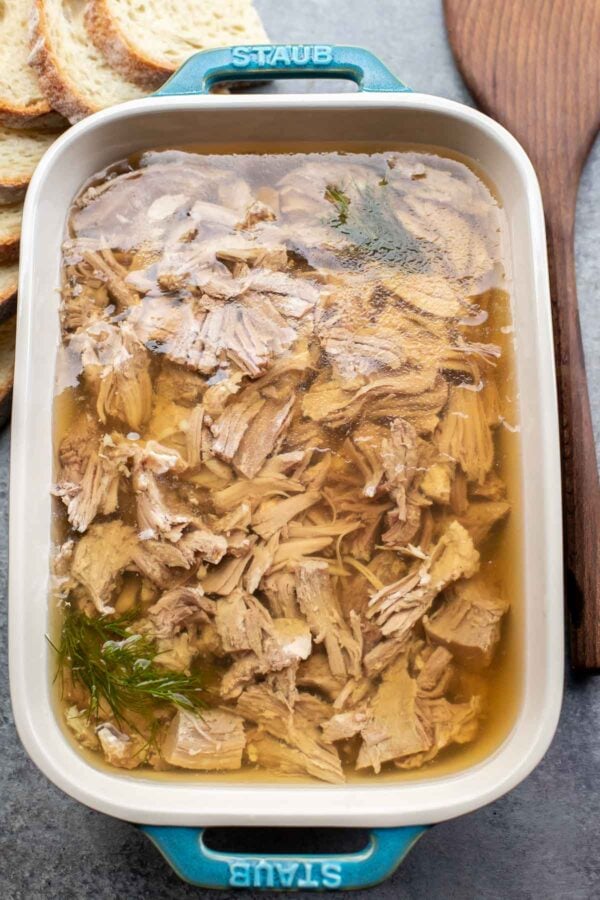
What is Kholodets or Aspic?
Both terms refer to a meat dish made of meat surrounded by flavorful gelatinized stock. Molded aspics were very popular in the 1950s but have long been forgotten. Not in Eastern Europe, though. Many Eastern European countries like Russia and Ukraine still serve this popular dish, especially around major holidays.
While the idea may sound strange, I call on you to be adventurous and try it at least once. So, what does it taste like? Aspic is served cold. As you take a bite, the heat of your mouth melts the rich meat stock flavored with parsley and fresh garlic and moistens the tender chunks of meat. Combine it with some spicy beet horseradish relish and a piece of good crusty bread, and you’ve got a true Ukrainian treat!
Types of Kholodets
There are two types of Kholodets and both require some kind of gelling agent to set the broth. One uses natural gelatin that’s extracted through long hours of cooking skin, tendons, bones, and ligaments of the animal, and the other one is made with commercially produced gelatin (I have that recipe for Kholodets here)
Both have pros and cons, but this recipe will focus on the traditional recipe that uses the natural gelatin extracted from the pork feet and hock through low and slow cooking. The flavor is extracted from deep within the bones, producing a rich broth as delicious as it is good for you.
Bone Broth (and Kholodets) is Good For You
Aside from the flavor benefits of this dish, did you know that Kholodets is amazing for your bone and joint health? The collagen, glutamine, and glycine extracted from the bones and released during cooking are good for the immune system and gut health. You can probably google “bone broth” to learn more about this.

Kholodets might not be the best dish to bring to your work potluck, as some might claim that it is for an acquired taste, but if it’s something you grew up eating and have always wondered how to make or are trying to be adventurous and try new foods – here it is!
How to make Kholodets:
Here’s a quick rundown of the whole process. Scroll all the way to the bottom for the detailed recipe and ingredients.
- Add the meats to a large pot and cover with water. Cook for 5 minutes, then drain the water.
- Cover the meat with fresh water again and simmer on low heat for 5 hours, adding more water as needed to keep the meat covered.
- Then, add carrots, onions, and bay leaves and cook for another hour.
- Remove the meat to a bowl and cool. Remove the onions, carrots, and bay leaves, and discard.
- Add parsley and garlic to the broth and simmer for 2 minutes.
- Drain the broth through paper towels to remove all impurities. Cool to room temp.
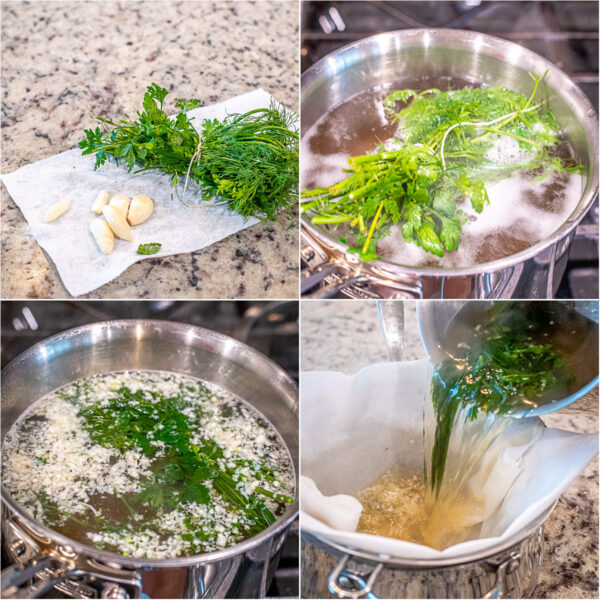
- Discard the pig’s feet, skin, bones, and fat from the cooled meat. Shred the meat and add to a 9″x12″ glass baking dish.
- Pour half the cooled broth and refrigerate until the broth is lightly set.
- Pour the other half of the broth on top, cover with plastic wrap, and refrigerate until fully set.
- While the kholodets is setting in the fridge, make the beet and horseradish sauce by combining all of the ingredients in a bowl. Cover and refrigerate until needed.
Scroll to the bottom for the recipe card with ingredient amounts and precise recipe.
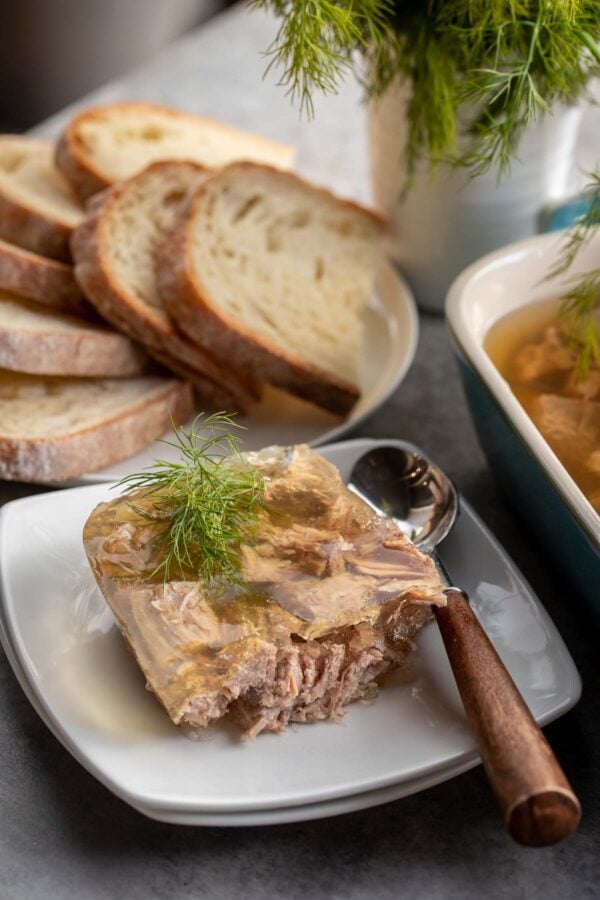
How to get clear Bone Broth Kholodets
Anytime I make broth, I take great care to ensure it’s as clear as glass. It definitely adds to the visual appeal of the dish.
There are two things you need to do to ensure clear broth.
- One – you must ensure the meat is cooked at a very low simmer. Rapid boiling breaks up any impurities from the meat into tiny pieces that make the broth cloudy. So low and slow is the way to go.
- Two – once the meat has cooked and all the flavor has been extracted from the bones, meat, etc., you need to drain the broth through several layers of paper towels. The towels will catch any tiny pieces of impurities and fat that would’ve otherwise created cloudy meat aspic.
They’re extra steps that really make a difference!

Instant Pot Kholodets
Kholodets is one of the most amazing things to make in an Instant Pot because not only it cuts down the cooking time, it produces the clearest broth without any effort from you (you know, no skimming).
Read the bottom of the recipe card to find directions on making the Kholodets in the pressure cooker.
To make kholodets, I simmer the meat low and slow for many, many hours. This extracts all the flavor out of the bones and meat. Combined with the spicy horseradish sauce, this one is a true Ukrainian treat.
Can I use other types of meat in place of pork loin or beef chuck?
Other types of meat that you can use as a replacement would be – chicken breast, thighs, or drumsticks, as well as pork shoulder.
What to serve with kholodets?
Kholodets is typically served with spicy beet & horseradish relish. The recipe for it is included in the recipe card below.
Other foods that can be served alongside kholodets are mashed potatoes, golubtsi (stuffed cabbage rolls), stuffed peppers and Olivier potato salad (a fancy Russian potato salad).
Kholodets – Aspic Recipe
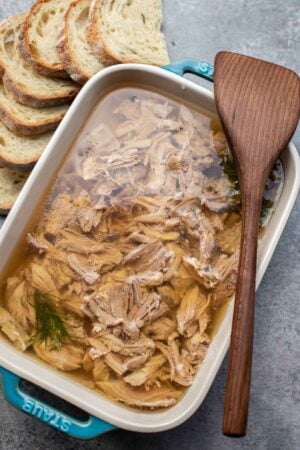
Kholodets or Meat Aspic is a traditional Ukrainian dish that is served with spicy horseradish and beet relish. It is made with tender meat chunks and delicious gelatinized broth.
Ingredients
The meat for Kholodets
- 2 pigs feet
- 1 pig’s rear hock
- 2 lbs beef boneless beef chuck fat trimmed
- 2 lbs pork loin fat trimmed
The aromatics (add in the last hour of cooking)
- 2 large onions peeled
- 2 large carrots peeled
- 2 stalks celery rinsed
- 15 black peppercorns whole
- 2 bay leaves
- 1.5 Tbsp kosher salt
- 2 qts cold water (this amount is approximate, use more if needed)
Add after removing all meat and vegetables from the broth
- 1 bunch parsley washed under running water
- 6-8 cloves garlic peeled, minced
For the Beet & Horseradish Sauce
- 1 large beet *(or one 15oz can of canned beets, drained) cooked, peeled, finely grated
- 2 1/2 Tbsp white vinegar
- 2 1/2 Tbsp granulated sugar
- 1 1/4 tsp kosher salt (use less if using table salt)
- 6 Tbsp extra hot horseradish sauce (I use Beaver Brand) (Or, freshly grated horseradish root)
Instructions
How to make Kholodets (Meat Aspic)
-
1st boil: To a large 8 qt pot add 2 pigs feet, 1 rear hock, 2 lbs pork loin, 2 lbs of boneless beef chuck, and add enough water to cover the meat. Bring to a boil and let simmer for 5 minutes. Next, remove the meat to a clean bowl. Discard the cooking liquid and wash the pot clean.
-
2nd boil: Add all the meat back to the pot, cover with fresh water and bring to a boil. Then, reduce the heat to a gentle simmer and cook for about 5 hours. All throughout cooking constantly skim the top from impurities with a slotted spoon. Do not cover with a lid.
Tip: Preventing rapid boil and keeping the lid off while simmering will ensure that the broth comes out clear and not cloudy.
-
Keep an eye on the water level – add more if needed to keep the meat submerged at all times. If needed add a smaller-sized lid or dinner plate to the top of the meat to weigh the meat down and keep it under the water.
-
Add aromatics: Now add 2 onions, 2 carrots, 3 stalks celery, 15 black peppercorns, 2 bay leaves, and 1 ½ Tbsp of salt to the stock. Continue simmering for 1 more hour.
-
Remove solids: Remove all meat chunks from the broth to a large bowl. Remove and discard the remaining vegetables (onions, carrots, and bay leaves).
Line a large sieve with 3 layers of paper towels or several layers of cheesecloth and set it over a clean pot. Pour the broth through the paper towel lined sieve to remove impurities and fat.
-
Add parsley to the strained broth and simmer on low for 1-2 minutes. Remove the parsley and discard. Add 6-8 cloves minced garlic. Allow cooling completely.
-
Once the meat has cooled, discard the pig's feet, any bones, fat, or skin.
Shred the meat into bite-sized pieces and add to a 9"x12" baking dish in an even layer.
To make the meat aspic in individual portions, portion the meat between deep soup bowls or other small, but deep containers.
Cover & refrigerate until ready for next step.
-
While the meat is cooling, drain the cool broth: set a sieve lined with 2-3 layers of paper towels again over a large pot. Carefully drain the broth to remove any remaining solids, fat, or impurities. Change the paper towels as the broth stops flowing through – the fat creates a barrier and prevents the liquid from going through.
To get an absolutely fat-free broth, you might need to drain the broth through paper towels several times. Any fat left in the broth will cover the aspic in white patches as it solidifies if not removed at this stage. For best results, cool the broth to room temperature before using it in the next steps. Otherwise, pouring hot broth over the meat will melt the fat in the meat and make it float to the top.
Tip: The quickest way to cool the broth is to set the pot with the hot broth into a sink full of cold/icy water and stir it every so often until the broth cools.
-
Add half the broth to the meat: pour half of the cooled to room temperature broth over the meat. Skim any fat that floats to the top with a spoon. Refrigerate for about 45 minutes to slightly set. This will prevent the meat from floating to the top as you pour the other half of the broth. Keep the other half of the broth mixture at room temperature as the first half sets in the fridge.
-
Add the remainder of the broth: Once lightly set, remove the kholodets from the fridge and pour the remaining half of the broth over the top covering the meat completely. Add leaves of parsley for garnish if desired. Cover with plastic wrap and refrigerate until completely set, about 4-5 hours or overnight.
-
Once set, cut into 2×2 squares and serve alongside some beet & horseradish relish.
To make the beet & horseradish relish:
-
Shred the cooked beet on the zester side of the box greater. Let sit in a sieve for several minutes pressing out any extra liquid out. Transfer to a bowl
Combine 1 large cooked and finely grated on the zester side of the greater beet with
-
Combine the shredded and drained beets with 2 1/2 Tbsp vinegar, 2 1/2 Tbsp sugar and 1 1/4 tsp salt. Lastly, add 1/2 of the horseradish sauce (3 Tbsp) and stir everything to combine. Taste and continue adding the remainder of the horseradish sauce, a little at a time until desired spiciness level is reached. Keep in mind that as the relish sits in the fridge it will lose some of the spiciness.
Recipe Notes
TIPS:
You can use any other kind of meat instead of pork loin and the beef chuck, equal by weight to the one listed in the recipe. Do not replace the pig’s feet or the hock; they act as the gelling agent in the kholodets.
Instant Pot Kholodets:
For this amount of ingredients an 8 Qt Instant pot is needed. You’re welcome to halve the recipe and use a 6 qt pressure cooker.
Follow with the ingredients in the recipe (meats, aromatics & seasoning spices), but only add enough water to the pot to barely cover the meat. While cooking in the Instant Pot, the water does not evaporate like it does when cooked on the stovetop, so you do not need to add extra.
Seal the lid and cook on low pressure for 3 hours. If your Instant pot does not cook for longer than 90 minutes at a time (like some do), then restart it when the time expires and continue doing so until a total of 3 hours is reached.
Once the cooking time is complete, allow Natural Pressure Release (NPR), open the lid, skim the impurities that floated to the top, remove the meat carefully, and continue with the rest of the instructions on clarifying the broth and beyond.
Thank you for following me on Instagram, Facebook & Pinterest!
Hashtag your photos #LetTheBakingBeginBlog so I can see your creations and for a chance to be featured!


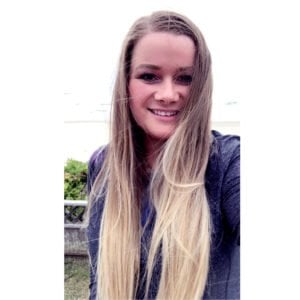
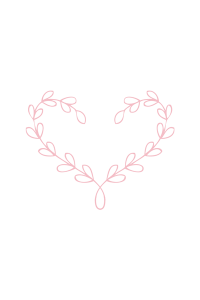


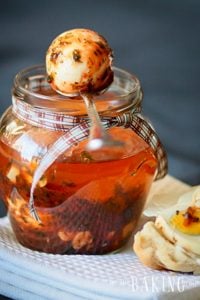
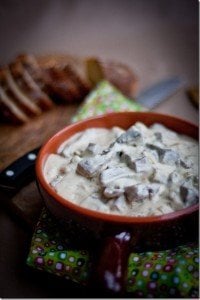


How would you make this pork free. Is it possible?
This recipe is made with beef.
Just wondering, for the instant pot version do you do the first boil at all? Also, can you cook the meat from frozen in the instant pot?
Brilliant recipe! Quite different from our own version of aspic here in Japan and the beet sauce is an absolute knockout.
Thank you for this recipe. I grew up with kholodets and this is just like my mother makes. Sometimes you get a taste for it but not enough time to make, so I would like to try the instant pot version. At what point do you add the aromatics?
Hi Ivanka, I add them together with the meat when I load the Instant pot before adding the lid and sealing it for cooking.
I grew up eating this to as I’m half Ukrainian. Grandma and mum add chicken wings, thighs on the bone or drumstick in with the other meats. Loved it! Glad you used lots of garlic and parsley as we do. Yummy!!!
Garlic and parsley are key in kholodets, so we like lots of it 😀
Spasiba.
As a child who grew up on a farm where we butchered our own meat, I am familiar with this dish, although we used the Polish name for it, salceson. It’s a way of using a great deal of meat that would otherwise be wasted, and can be made from very economical cuts from your butcher as well. My family seasoned it with garlic and sage.
A few things: it is delicious, but there is no way to convince an eight year old American who wants a plate of chicken nuggets and fries to come within yards of it. It’s one of those dishes you have to be introduced to early on.
Pigs feet in aspic are delicious as well, although it used to make my hair stand on end when my father ate them.
If your Slavic relatives have kept you up late with a bottle of Sobieski, this is just the thing to clear your head and restore your faith the next morning.
There are many regional variants. It is known as brawn or souse in the UK, souse being made with vinegar. There are at least three German types, and practically every country from Spain to Finland has a national recipe.
Long mis-regarded as peasant food, people are again discovering the joy of dishes of this nature. Pennsylvania scrapple is another. There are folks from the southern US that will crawl across hot coals for a plate of livermush.
If the meat is finely chopped and vegetables placed artistically in the aspic, it’s a dish that can grace the most formal table.
Thank you so much for sharing so much of interesting and unknown to me history, loved reading it all!
Spasiba.
Thank you for a detailed recipe. I make an almost identical version and you’ve included all the tips for making the best kholodets. Without those little secrets/tips it just won’t be the same. Printing your recipe for my family’s recipe book.
Hello, thank you for recipe. Can you tell me what horseradish sauce did you buy. Because I buy a lot and they not hot enough
Hi Luda,
I know the trouble. We used to get the horseradish sauce from the russian store and were disappointed most of the time as the sauce was hit and miss. Sometimes it was hot, and sometimes there were just remnanants of that “hotness”. I think it’s due to sitting on the shelf too long.
Now, we buy this one (Beaver brand) and you can get the regular or the “hot” one. Both are a lot spicier than what we got at the russian store.